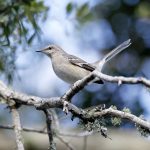If you’ve been stuck at home during the pandemic, absentmindedly looking out the window, now you can do something different.
You can look out the window but count the birds.
You’ve probably been seeing birds all along, but by taking note of what stops off or flies past between Friday and Presidents Day, you can join the Great Backyard Bird Count.
Birds that you report help scientists keep track of where different species are migrating, flourishing or diminishing.
To take part, you need to do just two things:
- Open an eBird account. It’s free. You can join with your smartphone or computer.
- Spend a minimum of 15 minutes counting.
It’s easy enough that last year, more than a quarter-million people around the world participated and counted 7,113 species.
But you don’t need to recognize anywhere near that many birds.
In Pennsylvania, 152 species made last year’s count — still way more than one backyard observer needs to know.
If you’re new to this, narrow your focus.
Audubon Pennsylvania lists 30 birds you’re likely to see in your neighborhood.
Megan Fedor, who is adept at spotting birds after years of leading classes and guiding hikes as an environmental educator at Nescopeck State Park, set a goal of spotting 15 species for her family at their home.
On Thursday, the day before count begins, Fedor has scheduled a virtual class in which she will tell how to take part and review common backyard birds.
Sign-up for her program, which starts at 7 p.m., on the calendar of the state Department of Conservation and Natural Resources.
“My best tip is just to spend some time watching. Leave behind any distractions and look out your windows or go for a walk,” Fedor said via email. “You’ll find the most birds around food sources,” like a bayberry shrub outside her office window.
In addition to berry bushes, she watches trees with cones or catkins, open water and feeders.
Fedor has been paying more attention to her feeders this year because she isn’t traveling to birding spots for daytrips or vacations due to the pandemic.
At Hawk Mountain Sanctuary, researchers postponed a trip to tag vultures in Arizona and other studies because of the pandemic, said Laurie Goodrich, director of conservation science at the sanctuary’s Acopian Center for Conservation Learning near Molino.
“We had to do our spring hawk watch with only staff covering the lookout, one at a time,” Goodrich said in an email. She plans to log birds for the backyard count from her home.
While the pandemic has led researchers and tourists to put off birding trips, the bird count compiles sightings for them from across the globe.
The eBird.org website, managed by the Cornell Lab of Ornithology, enters reports of sightings into statistical models to produce maps, animations and statistics.
From the models emerge migration paths, range and relative abundance of hundreds of species.
Statistics show the prevalence of a bird in a region. For example, fewer than 1% of ruffed grouse in North America live in Pennsylvania, where it is the state bird.
While that information helps scientists and policymakers, eBird also saves information about what you saw from year to year. That lets you make comparisons about effects that heavy storms or changing climate had on the count.
“It isn’t just a scientist telling us something; through our personal birding we can see it for ourselves,” David Kruel said.
When a pandemic isn’t raging, Kruel leads group bird walks at state parks in Luzerne and Schuylkill counties. While COVID-19 cut down on his birding trips, it hasn’t reduced the time that he spent watching birds, especially in spring when his company shut down and he had more time to wander.
During the backyard bird count, he will look near his home in Schuylkill. Usually he finds chickadees, titmice, nuthatches, woodpeckers, blue jays and cardinals that live there year round. Winter migrants like juncos, tree sparrows, wrens and brown creepers often make his checklist.
“If I am energetic and get out for some farm field birding, I may find species such as horned larks, snow buntings or even a rare Lapland longspur in corn stubble,” Kruel said in an email while mentioning that buntings and longspurs nest in the arctic.
While 15 minutes is the minimum time for participating in the Great Backyard Bird Count, there is no maximum.
You can report checklists of birds that you see every day of the count. Or several times a day.
Counting need not take place in your backyard, either. You can take walks in parks, woods, lake shores or wherever birds gather.
“For me, and I think many other folks, birding is very addictive,” Kruel said. “The more you bird, the more you want to do it.”

Even after three decades as a reporter at the Standard-Speaker, Kent Jackson still enjoys meeting people, learning more about the community and sharing stories with readers. He currently covers schools but has reported on local government, health, police and the environment. Regularly, he writes about outdoor sports, wildlife and conservation for the Wildlife page on Sundays. Contact: 570-455-3636; kjackson@standardspeaker.com




